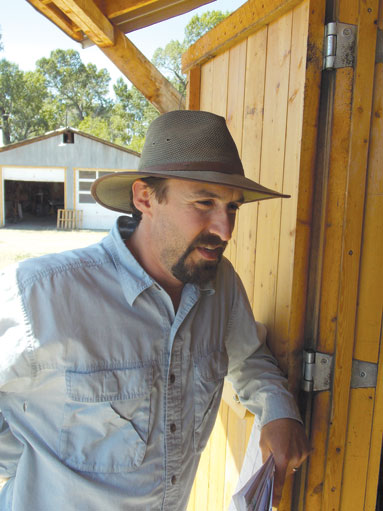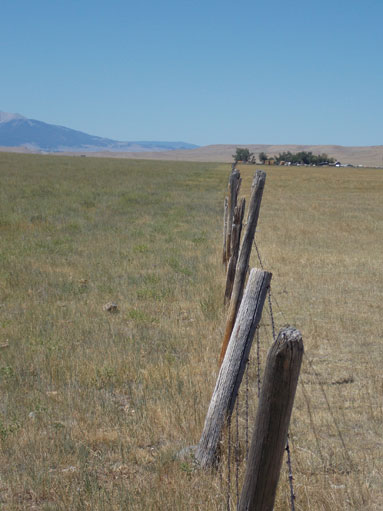It is an old idea: Let grazing herds naturally replenish their food source.
Just as bison created vast grasslands in North America, from Texas to Saskatchewan, yearlings here on 150 acres ringed with an electrical wire are harvesting forage, stirring up soil, fertilizing it with their waste and moving on.
The 1,000-head herd was projected to spend six days on this parcel before moving to the next pasture, but recalculation of forage cut it to three. They’ll go to market early this fall.

A detailed map of the ranch, divided into 69 pastures – all with access to water from wells and American Fork Creek – allows Zach Jones to maximize his resources.
Parcels can be further divided by running a single strand of charged wire wherever needed.
Although the operation buys some hay for winter, the overall goal is to feed cattle with grass provided by a healthy landscape.
The Savory model
Three years ago, Jones and several like-minded individuals gathered in the Colorado mountains to form the Savory Institute, named after Allan Savory of Zimbabwe who, in the early 1980s, began to educate U.S. land managers in a different way of caring for range.
Savory, after closely observing migrating herds on the African veldt, concluded that grasslands regenerate faster and better when grazing is intense over a short time. Savory was wont to say about U.S. range: “I’ve never seen lands so overgrazed and understocked.”
He explained that seeming contradiction in that the land’s capacity for grazing was greater than the number of animals on it, but U.S. practice allowed animals to graze for extended periods of time, damaging the resource.
Savory argues that intense grazing over a short period of time replicates the habits of migratory herds. Jones and his compatriots are using that principle in managing their own lands as well as contracting to manage other large tracts of privately owned ranches.
The Savory Institute is composed of Jones, Tony Malmberg of Oregon, Jim and Daniela Howell of Colorado, Savory and his wife, Jody Butterfield, and Shannon Horst of New Mexico.
Talkin’ about a revolution
Their goal is to incite a “Brown Revolution,” or healthy range soil, in contrast to the “Green Revolution.” The latter refers to a series of research developments and technologies occurring between the 1940s and late ’70s that increased crop production around the world, most markedly in the late ’60s.
Led by plant scientist Norman Borlaug, later awarded the Nobel Peace Prize, the Green Revolution developed high-yield varieties of cereal grains, expanded irrigation infrastructure, distributed hybrid seeds and provided synthetic fertilizer and pesticides to farmers.
The Savory Institute is a for-profit entity that seeks to create global awareness, access capital and influence more landscapes than just its owners, Jones said. Grasslands LLC is the management arm with Jim Howell as CEO and Jones as COO.
Besides their own ranching operations, Howell and Jones oversee 14,000 acres at Newell, South Dakota, 39,000 acres at Powderville near Broadus in southeastern Montana and 52,000 acres at Cohagen, Montana, between Miles City and Jordan. That area was known as the Big Open during the days of free range in the 1880s.

Stocking formula math
“We have less cattle on the land this year,” Jones said. In 2011, there was an abundance of moisture – this year an abundance of dry. In 2011, with two ranches under management, there were 1,900 cow-calf pairs and 4,000 yearlings. This year there are 3,500 pairs on the three ranches, Jones said.
“At Broadus, more cattle this year; in South Dakota, less than half than in 2011,” he said. “At Cohagen, slightly less than last year. Overall, in aggregate, the stocking rate, in stock days per acre, is down 16 percent from last year.”
The management plan is based on a stock-day-per-acre basis. This formula requires a precise calculation of available forage in a pasture and the daily requirements of the cattle on the land.
Jones explained it this way: A 1,000-pound cow requires 3 percent of its body mass in dry matter each day, so 30 pounds of forage equals one stock day.
A cow of 1,300 pounds with a 400-pound calf requires 51 pounds of forage a day. If the forage calculation for the ranch is 40 stock days per acre, that means 12,000 acres produce 480,000 stock days.
The difficulty lies in that each pasture has to be evaluated for how much forage it has, and that can vary widely. “The number-crunching goes on constantly,” Jones said. “It requires intense planning, monitoring, re-planning.”
“If you stay with the (original) plan, you’re going to have a wreck,” said Howell. “The theory is sound but the execution is hard. It requires discipline and constant monitoring. Things can go wrong quickly.
“It requires more thinking and smarter labor,” he added.
Funding for the three ranches came through the Capital Institute headed by former Wall Streeter John Fullerton and his partner, Larry Lunt, a Belgian citizen and U.S. resident, Jones said.
When the Savory Institute laid out the ideas for managing the grasslands and producing beef at a profit on the grass, “investors wondered why are not others doing the same,” Howell said.
Jones said the goals of financial, social and ecological success can be achieved by the management of land, money and people. “It is a triple, bottom-line impact investment,” he said. “We want this to be a template for others – ranchers and public-policy makers.”
It is an investment in grass that produces protein and profit for owners and land. ![]()
PHOTOS
TOP:Yearlings on a 150-acre parcel of grassland on the Jones Ranch.
MIDDLE: Zach Jones, 33, of Harlowton, Montana, is the chief operating officer of Grasslands LLC and operates the Jones Ranch nine miles south of Harlowton with his father, Bill.
BOTTOM: Fenceline of a pasture that has not been grazed since October 2011. It will be used this year in late fall; contrast neighbor’s pasture on the right. Crazy Mountains shown in background. Photos courtesy of Jim Gransbery.






